
Skinned: Squales Rays

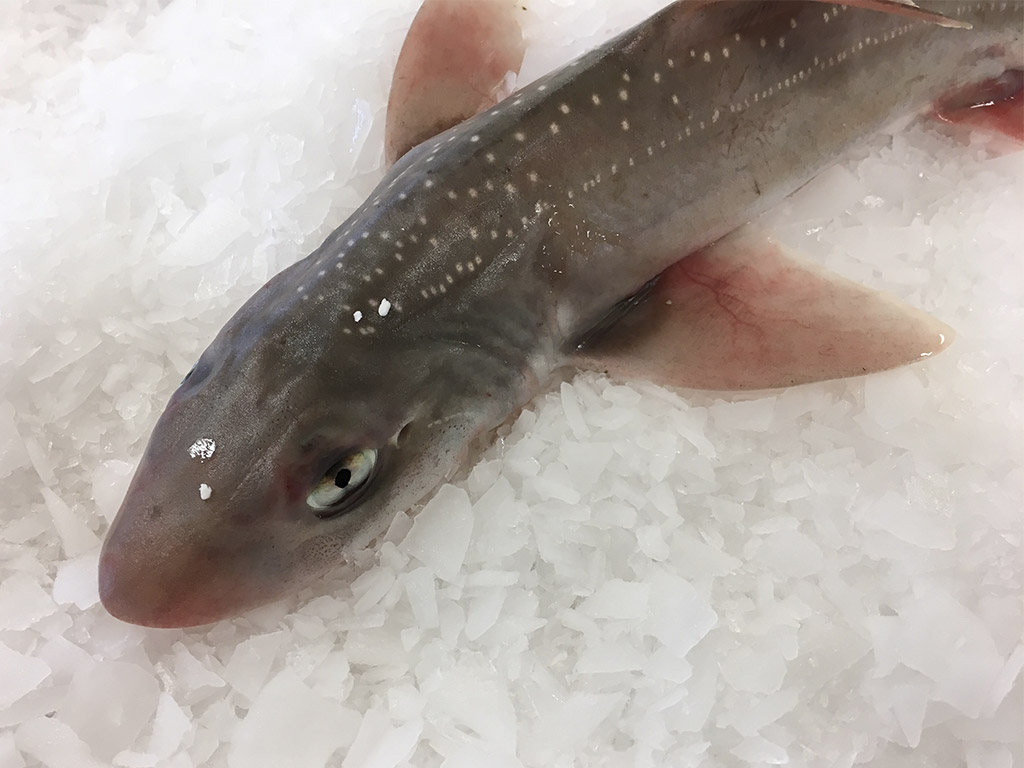

Emissole / Batoidea
Presentation of the emissole
As with all sharks, the gas bladder is absent and the bodies of the emissoles are covered with bone platelets. The head is provided with 5 gill slits. The general colour of the emissole is grey to greyish-brown. The back and top of the flanks of the spotted emissole are punctuated by light spots.
Quality :
Inshore fishing” emissoles
Emissole trawl
Proposed transformation:
Completely emptied emissole
Emissole peeled and decapitated *
Size & Packaging :
The emissole is packaged in 8/10 kg or as a piece.
*Packaged according to your needs



Dogfish/ scyliorhinus stellaris
Presentation of the dogfish
The dogfish is a coastal species and is very famous for its tender and pink flesh. Without bones, it is very easy to prepare. Very low in fat and very digestible, it is ideal as part of a balanced diet
The spotted dogfish is a member of the small shark family, even though it is only 80 cm long on average and lives on our coasts (especially in the Mediterranean). Red-spotted skin, elongated pupils and dorsal fins near the tail make the dogfish a spectacular fish.
Quality :
Roussette “coastal fishing”
Trawl dogfish
Proposed transformation:
Peeled and decapitated dogfish *
Size & Packaging :
*Packaged according to your needs



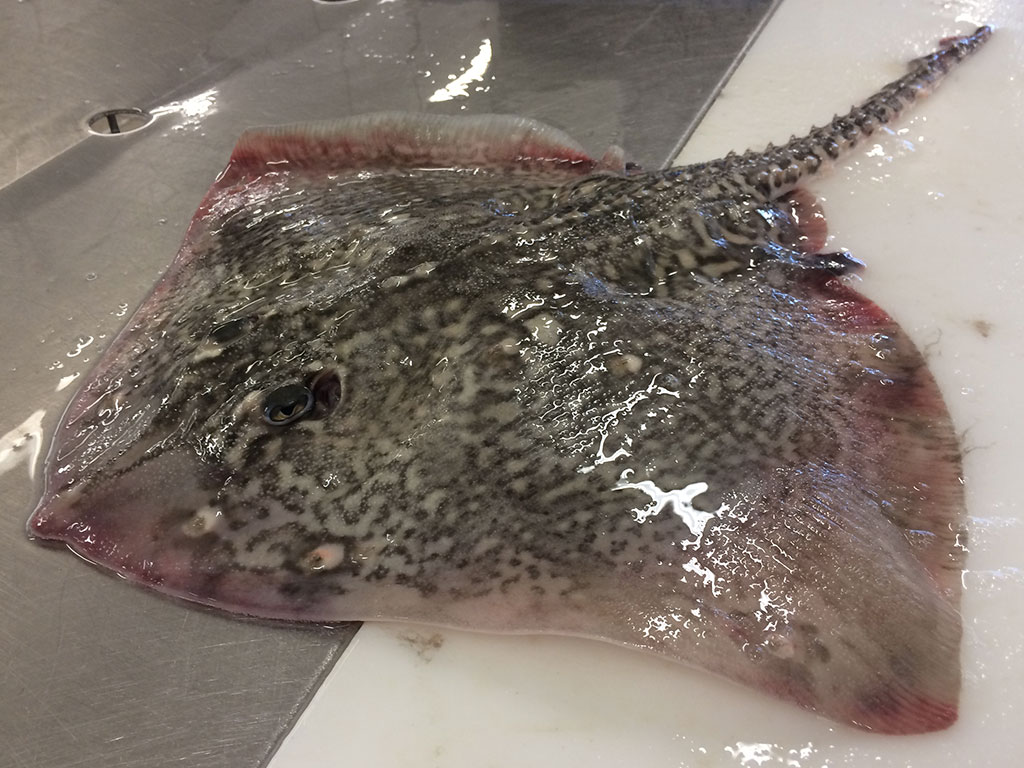


Stingray / Batoidea
Presentation of the ray
Measuring up to 2 m depending on the species, the skate is found in shallow water in sandy bottoms where it buries itself sheltered from nets. There are about thirty species that are not all edible. The curly parting with the most delicate flesh.
Quality :
Stingray Flowered or Stone Stingray
Curly skate
Soft or Smooth Stingray
Proposed transformation:
Whole skate *
Peeled skate wing with or without flap
Stingray cheek*
Size & Packaging :
Stingray is packaged in 2,3 or 6 kg and according to the following sizes: 2/400 gr – 3/500 gr – 500/1kg – 1 + kg
*Packaged according to your needs.
Fine fish
Grouper / Epinephelus marginatus
Presentation of the grouper:
With its massive body, imposing head, thick mouth and rounded tail, the grouper has an easily recognizable appearance. In fact, the term “grouper” includes several dozen distinct species, the most common of which is the brown grouper. It is brown-grey in colour, can measure up to 2.6 metres and weighs nearly 400 kilos. A voracious animal, it feeds mainly on molluscs, octopuses and small fish.
Quality :
Grouper “coastal fishing” grouper
Proposed transformation:
Whole grouper
Grouper fillet *
Size & Packaging :
The grouper is packaged in the form of trapping.
*Packaged according to your needs.
Red Mullet / Mullus surmuletus
Presentation of the red mullet:
The red mullet has, as its name suggests, a reddish-coloured coat, and as its name suggests, a pair of chinstrap bars that serve as tactile and gustatory receptors to flush out and devour its prey. In France, there are two types of red mullet that are not uncommon to find side by side: the barbet rock mullet (brightly coloured) and the mud mullet (duller).
Quality :
Red mullet with barbet flakes or trammel peach
Coastal red mullet
Proposed transformation:
Red mullet whole or gutted
Fillet of red mullet *
Size & Packaging :
The red mullet is packaged in 3 kg or as a piece and according to the following sizes: 1/200 gr – 2/300 gr – 3/500 gr – 500+ gr
*Packaged according to your needs.
Brill / Scophthalmus rhombus
Description of the brill:
The brill is present on the continental shelf, from the North Sea to the Mediterranean. The catfish is a flatfish that lives on sandy and gravelly bottoms, usually between 15 and 70m deep. Close to turbot, it is distinguished by a more oval body and a smooth skin, without tubers. The brill feeds on worms, molluscs, small crustaceans and small fish.
Quality :
Brill “inshore fishing”.
Trawl brill
Proposed transformation:
Whole brill, gutted
Fillet of brill *
Size & Packaging :
The brill is packaged in 6, 10 kg or as a piece and according to the following sizes: ½ kg – 2/2,5 kg – 2,5/3 kg – 3/4 kg
*Packaged according to your needs


Pink pageot/ Pagellus bogaraveo
Presentation of the pink sea bream
The pink sea bream or pink pageot (Pagellus bogaraveo) is a fish of the Sparidae family. The size of its eyes has earned it the nickname “beautiful eyes” It feeds mainly on crustaceans, molluscs and small fish This species is hermaphroditic, most individuals are born male and become female when they reach 20 to 30 cm long. A part of the population never changes sex.
Quality:
Common pink sea bream
“Inshore fishing” Sea bream Trawl pink sea bream
Proposed processing:
Whole common pink sea bream, whole gutted and flaked
Shape of common pink sea bream
Size & Packaging :
The pink sea bream is packaged in 3.6 kg or as a piece and according to the following sizes: 3/500 gr – 5/800 gr – 800/1 kg – 1+ kg
*Packaged according to your needs.



Dorade Besugo / Pagellus bogaraveo
Presentation of the besugo sea bream
The Pink Sea Bream or Pink Pageot (Pagellus bogaraveo) is a fish of the Sparidae family. The size of her eyes earned her the nickname “beautiful eyes”. It feeds mainly on crustaceans, molluscs and small fish. This species is hermaphroditic, most individuals are born male and become female when they reach 20 to 30 cm long. A part of the population never changes sex.
Quality :
Belugo sea bream “coastal fishing”
Sea bream belugo trawl
Proposed transformation:
Whole belugo sea bream
Gutted blubbered sea bream
Grey belugo fillet *
Size & Packaging :
The bladder bream is packed in 3 or 6 kg and according to the following sizes: 800/1 kg – 1 /2 kg – 2/3 kg
*Packaged according to your needs.



Bar / Dicentrarchus labrax
Presentation of the Bar
The bass is the noble fish par excellence; it is the fisherman’s favourite prey. Its techniques are numerous and its fishing requires a good knowledge of its behaviour. Before you go into the details of bass fishing techniques, you must learn how to find it. It cannot be fished anywhere or anytime and this article will help you to understand its behaviour.
Quality :
Line bar
Ikejime Line Bar: The spinal cord and major blood vessels are severed at the head and tail, a long needle is pushed down along the spinal cord, and the fish is placed in ice water to bleed.
Bar Net, Tank bar, Trawl bar
Proposed transformation :
Whole sea bass
Bar emptied, flaked, “disused “*
Bar fillet*
Size & Packaging :
The bar is packaged in 3.6, 10/12 kg, in the form of a piece and according to the following sizes: 5/700 gr – 7/1 kg – 1/1.5 kg – 1.5/2 kg – 2/3 kg – 3/4 kg – + 4 kg
*Packaged according to your needs.


Sole / solea solea
Presentation of the Sole:
A queen species, its maximum size can reach 70 cm with a current size of 25 to 35 cm. It lives at a depth of 130 meters to the coast at the limit of fresh water. It lives on sandy and muddy bottoms. In spring, it approaches the coast as close as possible to the coast and returns to deeper waters in winter. It breeds from February to April. She hunts at night, thanks to her sense of smell, worms, crustaceans, small shellfish with very thin shells that she swallows whole. To differentiate it from its much more bland cousin, the Senegalese or tropical sole, notice the black spot on its fin near the gills and eyes.
Quality :
Inshore fishing” sole or Trawl sole
Proposed transformation:
Whole sole, Sole fillet*, PAC sole*, Peeled sole*
Size & Packaging :
The sole is packaged in 3.6 kg and according to the following sizes: 1/200 gr – 2/300 gr – 3/400 gr – 3/400 gr – 3/400 gr – 4/500 gr – 5/600 gr – 6/800 gr – 800/1 kg – 1+ kg
*Packaged according to your needs.
**Ready to Cook


Royal Sea Bream / Sparus aurata
Presentation of the Royal Sea Bream :
The sea bream is a coastal fish that grows less than 150m from the coast in the Mediterranean and Black Seas, in the English Channel and in the Atlantic in water depths from 1 to 40 meters.
The sea bream feeds mainly on shellfish and crustaceans that it finds in sand or mud. It can also be found near rocky environments where it consumes shrimp and crabs.
Quality :
Sea bream “coastal fishing”
Sea bream trawl net
Proposed transformation :
Whole sea bream
Gutted sea bream
Fillet of sea bream *
Size & Packaging :
The sea bream is packaged in 3, 6, or 12 kg or as a piece and according to the following sizes: 3/500 gr – 5/800 gr – 8/1 kg – 1/1,5 kg- 1,5/2 kg – 2/3 kg – +3 kg
*Packaged according to your needs.
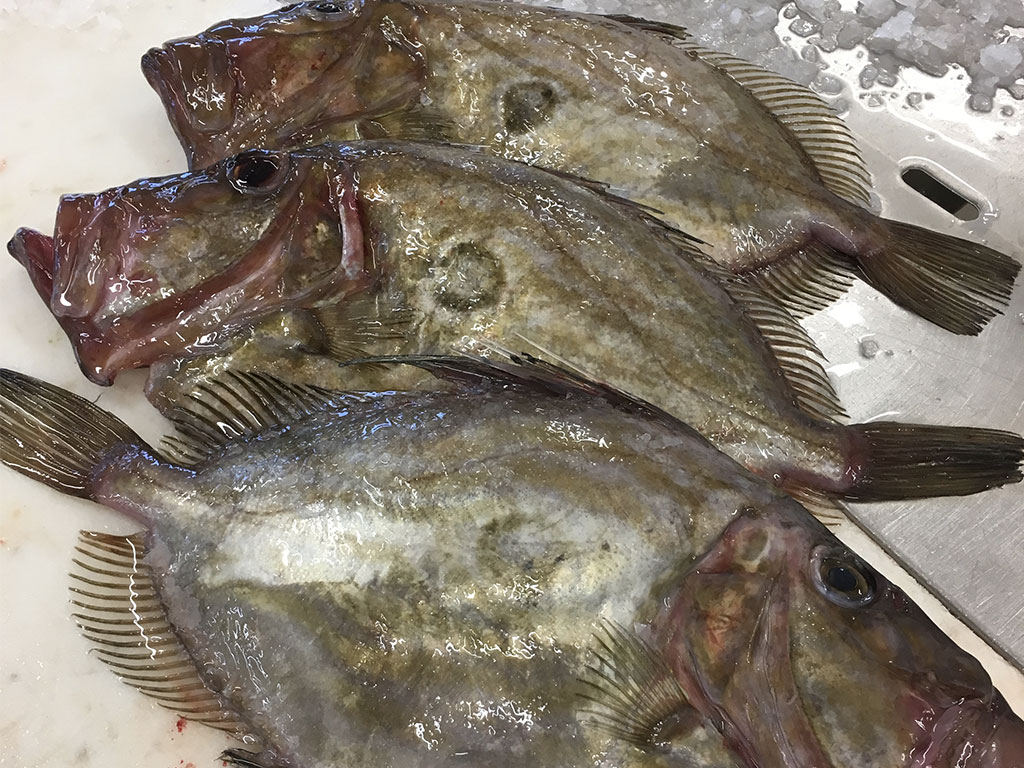
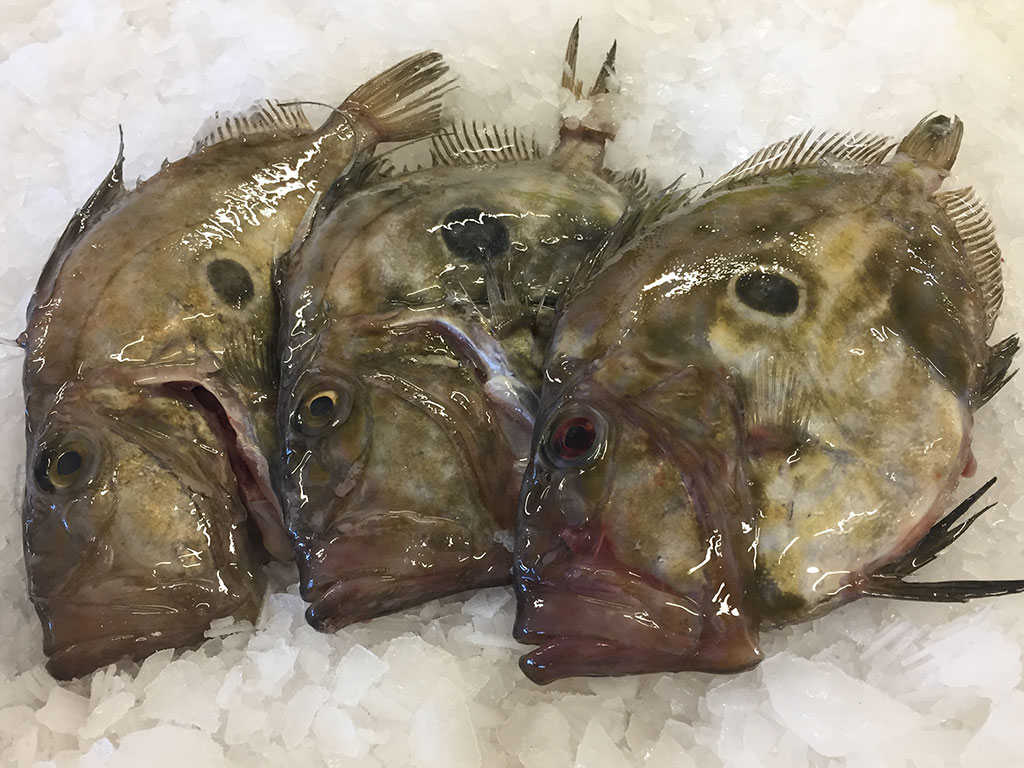
Saint Pierre / Zeus faber
Presentation of Saint-Pierre:
With its large head, which represents about a third of its laterally compressed body, and its thorny fins, the St. Pierre is recognizable among others. It is distinguished all the more easily by its characteristic black spot on its side.
Legend has it that it comes from the thumbprint and index finger of the apostle St. Peter (from whom he takes his name!) as he was removing a gold coin from his mouth. The scientific explanation, for its part, states that this task would serve as a camouflage eye to frighten predators.
Quality :
Saint-Pierre “inshore fishing”.
Saint-Pierre trawl net
Proposed transformation:
Saint-Pierre whole gutted
Saint-Pierre PAC **
Fillet of St. Pierre *
Size & Packaging :
Saint-Pierre is packaged in 3, 6.12, or as a piece and according to the following sizes: 3/500 5/700 gr – 7/800 gr – 800/1 kg – 1/1.5 kg – 1.5/2 kg – 2/2.5 kg – 2.5/3 kg – 3/4 kg – 4+k-
*Packaged according to your needs
**Ready To Cook

pagora / Pagrus pagrus
Presentation of the sea bream :
Pagrus is a Latin name for the pagora, certainly derived from the Greek name phagros, which means voracious. An animal with an average size of 15 to 60 cm, which can reach a maximum size of 91 cm. Its maximum weight is 19.00 kg.
Body fairly high and compressed laterally, head voluminous and abrupt. Very powerful jaws. Dentition similar to that of the Dorado (heterodontia), with 6 sharper incisors at the front of each jaw, followed by round molars.
Quality :
Sea bream “coastal fishing” dipper
Sea bream trawl
Proposed transformation:
Whole sea bream
Sea bream, flaked and emptied
Fillet of sea bream
Size & Packaging :
The sea bream is packaged in 3 or 6 kg and according to the following sizes: 3/500 gr – 500/800 kg – 800/1 kg – 1 /2 kg – 2/3 kg
*Packaged according to your needs.
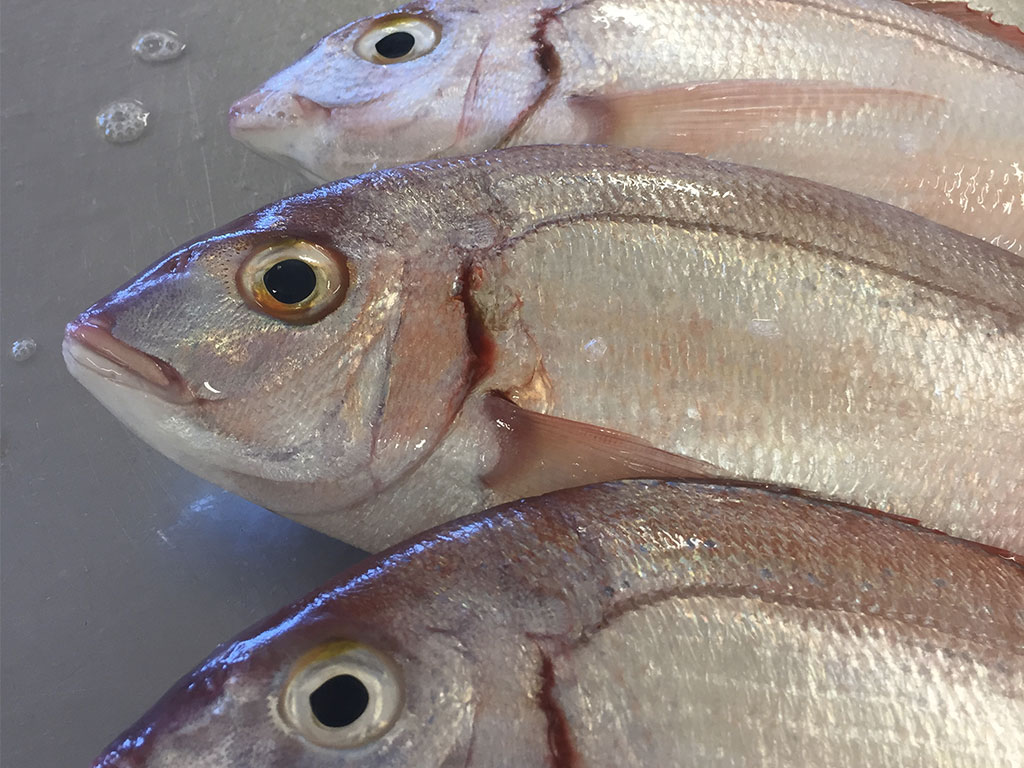

Pageot / Pagellus erythrinus
Presentation of the pageot:
Beautiful and good, the pageot has an excellent reputation among both fishermen and consumers. Sparidae pink-grey, this close cousin of the sar and the sea bream is distinguished by its oval body and laterally compressed, sometimes enamelled with fluorescent blue nets. A pointed snout, small eyes, a dark mark on the top of the head are all characteristics that make it easier to recognize this fish, which can reach up to 60 cm.
Quality :
Common pageot “inshore fishing”
Trawl pageot
Proposed transformation:
Common pageot whole, whole gutted flaked
Common pageot net *
Size & Packaging :
The pageot is packaged in 3.6 kg or as a piece and according to the following sizes: 3/500 gr – 5/800 gr – 800/1 kg – 1+ kg
*Packaged according to your needs.

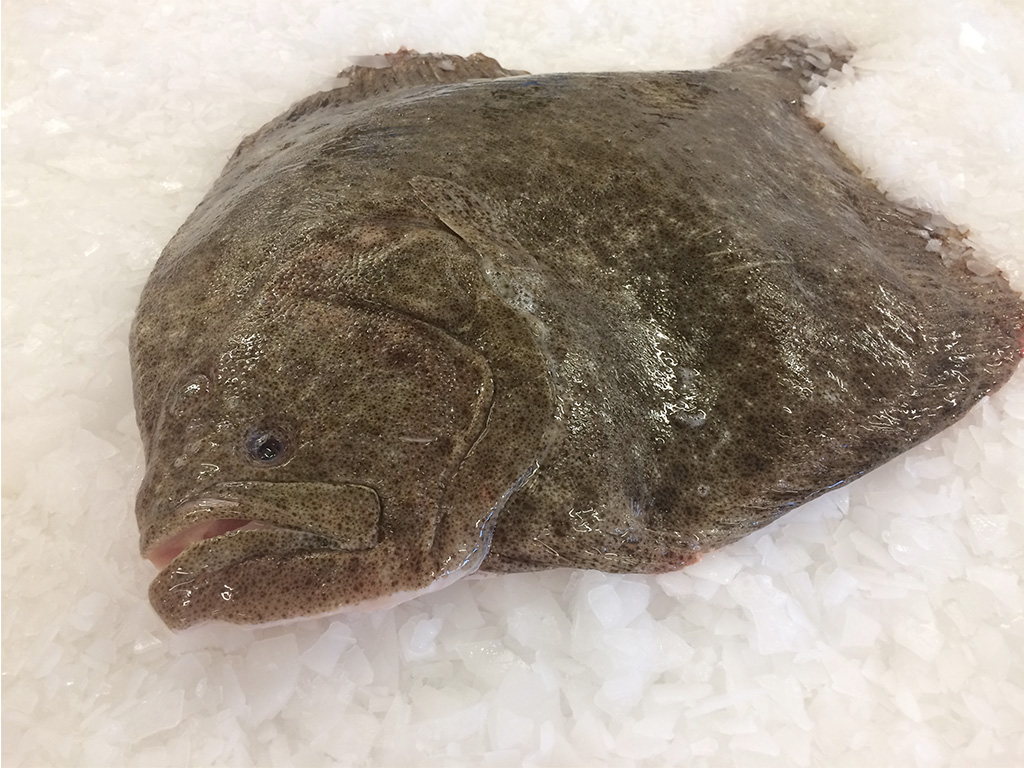
Turbot / Psetta maxima
Description of the turbot:
Turbot is one of the largest flatfish species that inhabit our coastal waters. Reaching a size of one meter and a weight of about twenty kilos, this rare fish with its delicate taste leaves no one indifferent.
This fish has a flattened body in the shape of a diamond. It has dark green eyes that are placed on the same side, the left. The animal rests on its right side and its other side is turned towards the light. The turbot has no scales, but its entire body is covered with small, sharp, bony tubers that make it rough to the touch. Turbot size
When mature, the average size of the turbot is 30 to 60 cm. In general, males are smaller (35 cm) than females (42 cm). Some individuals can reach a maximum height of 1 m.
Quality :
Turbot “Inshore fishing” turbot
Turbot trawl
Proposed transformation:
Whole turbot emptied
Turbot fillet *
Size & Packaging :
The turbot is packaged in 6.12 kg or as a piece and according to the following sizes: 500/1 kg -½ kg – 2/2.5 kg – 2.5/3 kg – 3/4 kg – 4/6kg – 6+ Kg
*Packaged according to your needs
Handmade fillet

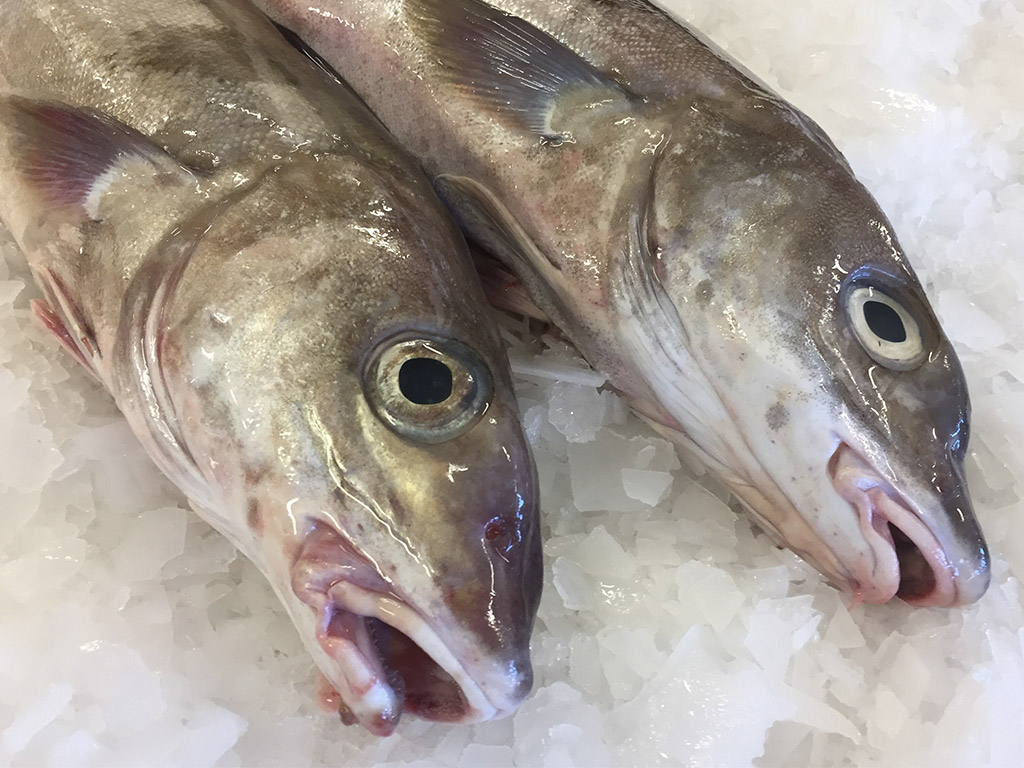
Haddock / Melanogrammus aeglefinus
Haddock presentation (Anon)
Haddock has the general appearance of the fish of its family, the Gadidae: fusiform body, three dorsal fins. His back is black. It has a black spot above the pectoral fin. The size of the haddock that can be found in shops varies between 30 and 50 cm. It is found in the North Atlantic. Adults live near the bottom, between 80 and 200 m, in waters between 4 and 10°C
Quality :
Haddock “Inshore fishing” haddock
Haddock trawl
Proposed transformation:
Whole haddock gutted
Beheaded Haddock
Haddock fillet*
Haddock back *
Size & Packaging :
Haddock is packaged in 10 kg or as pieces and in the following sizes: 1/2 kg – 2/3 kg – 3 + kg
*Packaged according to your needs.
Whiting / Melanogrammus aeglefinus
Presentation of whiting
Whiting is a bentho-pelagic fish found between 30 and 100 metres deep. It belongs to the family of gadidae (Cod, Saithe, Saithe…) The black spot it has at the base of the pectoral muscles and the dark lateral line are its distinctive features. Whiting reaches sexual maturity between 1 and 3 years of age, when it measures about 31 cm in the Celtic Sea, 25 cm in the North Sea and 20 cm in the Bay of Biscay. It can reach 70 cm and weigh 3 kg.
Quality :
Whiting line
Whiting Ikejime line
Whiting ” coastal fishing “.
Trawl whiting
Proposed transformation:
Whole gutted whiting
Fillet of whiting*
Size & Packaging :
The whiting is packaged in 3.6, 12 kg or in the form of pieces and according to the following sizes: 3/500 gr- 5/800 gr- 800/1 kg -1+ kg
*Packaged according to your needs.
Mostelle / Phycis phycis
Presentation of the mostelle
Mostelle, or Phycis de roche (Phycis phycis), is a species of marine fish of the subfamily Phycinae and the family Gadidae. It is a fairly common edible species in the Mediterranean, living in rocky cavities.
Phycis phycis can be recognized by the barbel under his chin and his elongated body. It has 2 dorsal fins, a small one at the pectoral fin and a long one starting at the end of the pectoral fin and continuing to the caudal fin. An annular fin follows the dorsal fin symmetrically, although a little shorter. Under the head, behind the gills, are 2 pelvic fins in the form of a ray split in 2.
Quality :
Mostelle ” coastal fishing “.
Mostelle trawl net
Proposed transformation:
Completely emptied mostelle *
Fillet of mostelle*
Size & Packaging :
*Packaged according to your needs

Lieu Jaune / Pollachius pollachius
Presentation of the pollack:
The pollack is a fish that can reach 1.2 m in length. His body is elongated and flattened laterally. It has three dorsal fins and two anal fins. Its lower jaw is larger than its upper jaw. The lateral line is clearly visible: it is curved above the pectoral muscles. Its colour is variable: the back is generally brown-green, the belly and sides are light with irregularly shaped yellow spots. The pollock lives in cold, deep waters; it moves near the bottom by snaking around obstacles it encounters: stones, rocks and wreckage debris. The most beautiful specimens can be found at a depth of 30 meters.
Quality :
Inshore fishing” pollack
Trawl pollack
Line pollack
IKEJIME Line Location: The spinal cord and major blood vessels are severed at the head and tail, a long needle is pushed down along the spinal cord, and the fish is placed in icy water to bleed it.
Proposed transformation:
Whole pollack
Beheaded pollack
Pollack CAP** Location
Pollack Locust Fillet*
Pollack’s Back*
Size & Packaging :
The pollack is packaged in 10,12, 18 kg or as a piece and in the following sizes: 2/3 kg – 3/5 kg – 5/7 kg
*Packaged according to your needs.
**Ready To Cook



Cabillaud / Gadus morhua
Presentation of cod
Cod, the most famous species among gadids, lives in the North Atlantic, from Canadian waters (in the west) to the Barents Sea (in the east). A cold-water fish, it does not descend much below the 48th parallel North. The female reaches her first sexual maturity when she is over 60 cm tall. Breeding takes place at temperatures between 4 and 6°C; it takes place in the North Sea from February to April. Cod can exceptionally reach 2 metres in length and weigh up to 100 kg. He can live 25 years
Quality :
Cod “inshore fishing”
Cod trawl
Proposed transformation:
Whole gutted cod
Beheaded cod
CAP cod **
Fillet of cod*
Cod back*
Salted cod fillet*
Size & Packaging :
Cod is packaged in 10.12, 18 or in the form of pieces and in the following sizes: ½ kg – 2/2.5 kg – 2.5/3 kg – 3/4 kg – 4+kg
*Packaged according to your needs.
**Ready To Cook
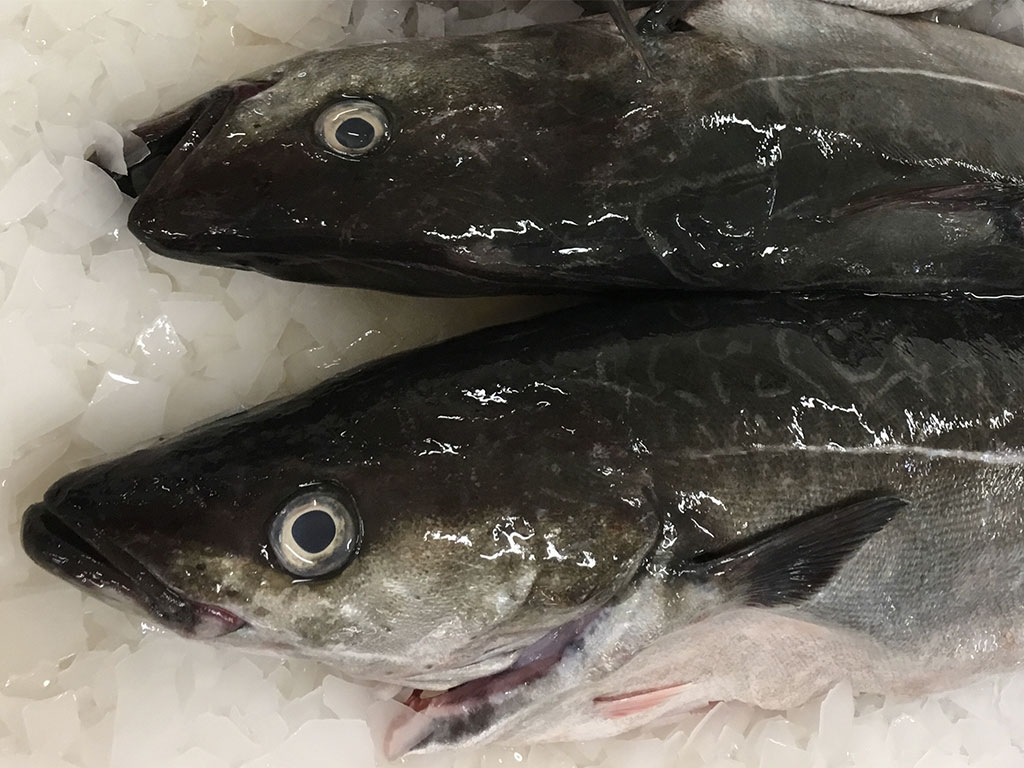


Saithe / Pollachius virens
Presentation of the saithe
Saithe has a particular taste, different from that of other white-fleshed fish. Its unique flavour is well suited to spicy dishes and its firm flesh is ideal for frying. The saithe or hake (France), or pollock (Canada), is a fish with a prominent lower jaw and silvery belly. From about 50 cm at the age of 5 years, he lives about thirty years and can then reach 1.3 m. It is an enduring predator whose swimming is relatively fast.
Quality :
Inshore fishing” saithe
Saithe trawl
Line Saithe
Proposed transformation:
Whole Saithe
Beheaded Saithe
Saithe PAC**
Filet of saithe*
Saithe back*
Size & Packaging :
The saithe is packaged in 10,12, 18 kg or as a piece and in the following sizes: 2/3 kg – 3/5 kg – 5/7 kg
*Packaged according to your needs.
**Ready To Cook
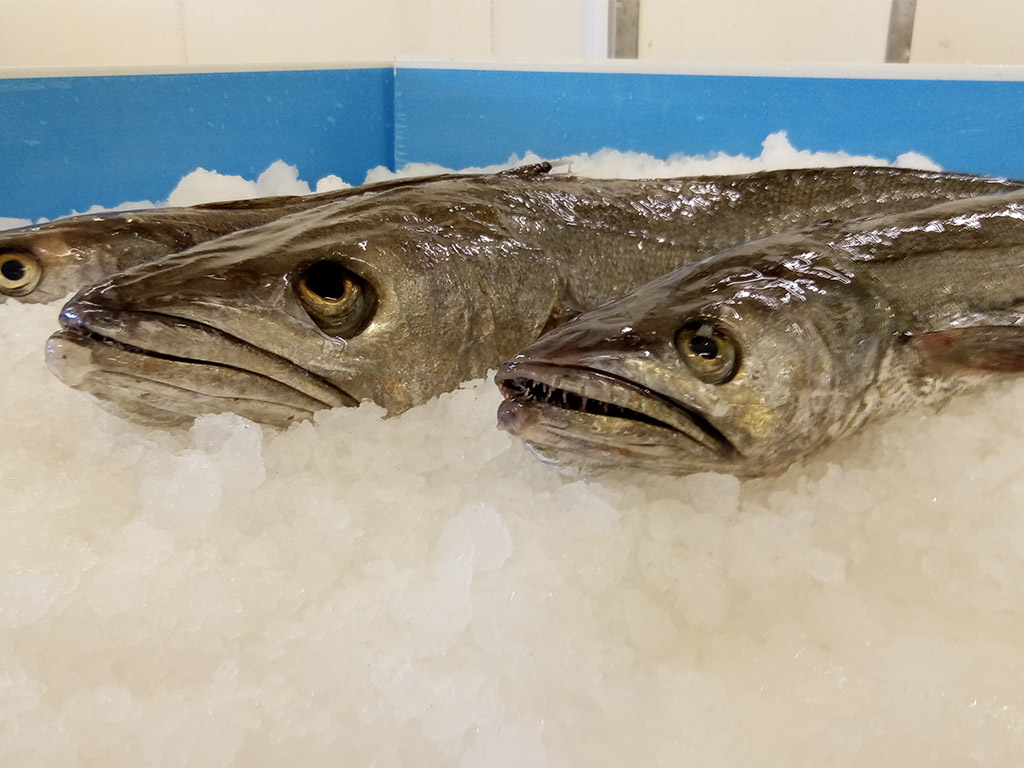
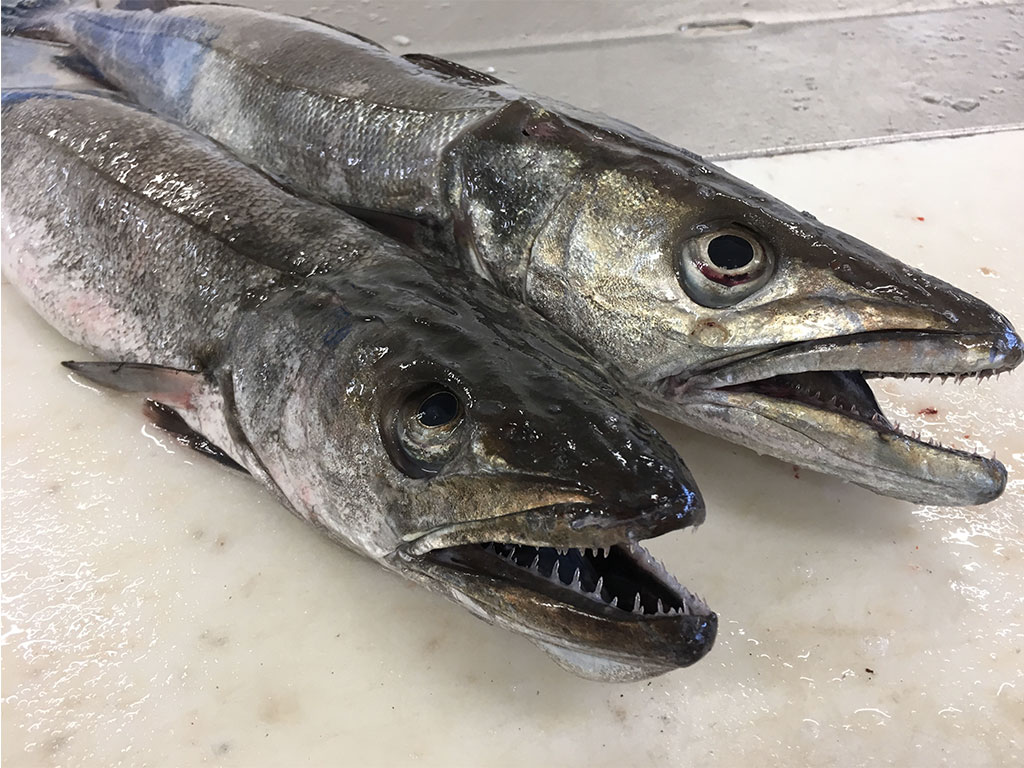
Common hake / Merluccius merluccius
Presentation of hake
The common hake, European hake or white hake, also known as hake, colinet, colinot, bardot, or whiting in the Mediterranean (Merluccius merluccius) is a marine fish species of the hake family. It is an exclusively marine fish, which lives at great depths, up to 1,000 m. It only returns to the surface at nightfall.
It measures from 30 to 110 cm. It has two large dorsal fins and an anal fin, a large mouth. The elongated, light grey body of the hake is characteristic; it lives in salt water.
Quality :
Hake ” inshore fishing “.
Hake trawl
Hake of line hake
Proposed transformation:
Whole hake gutted
Beheaded hake
Fillet of hake*
Hake back*
Size & Packaging :
Hake is packaged in 10,12, 18 or in the form of pieces and according to the following sizes: ½ kg – 2/2,5 kg – 2,5/3 kg – 3/4 kg – 4+kg
*Packaged according to your needs.


Julienne(molva-molva)/Elingue
Presentation of the Julienne
Ling, or julienne, is a marine fish that lives in deep temperate waters and measures 70 cm to 2 m long. Its very tapered body is covered by a two-part dorsal fin, a short one near the head and a long one extending towards the tail.
Quality :
Julienne “coastal fishing”
Julienne trawl net
Proposed transformation:
Whole sling emptied*
Julienne Fillet *
Julienne’s back*
Size & Packaging :
Packaged according to your needs
Whole Fish / Cut Fish


Haddock / Melanogrammus aeglefinus
Haddock presentation (Anon)
Haddock has the general appearance of the fish of its family, the Gadidae: fusiform body, three dorsal fins. His back is black. It has a black spot above the pectoral fin. The size of the haddock that can be found in shops varies between 30 and 50 cm. It is found in the North Atlantic. Adults live near the bottom, between 80 and 200 m, in waters between 4 and 10°C
Quality :
Haddock “Inshore fishing” haddock
Haddock trawl
Proposed transformation:
Whole haddock gutted
Beheaded Haddock
Haddock fillet*
Haddock back *
Size & Packaging :
Haddock is packaged in 10 kg or as pieces and in the following sizes: 1/2 kg – 2/3 kg – 3 + kg
*Packaged according to your needs.
Whiting / Melanogrammus aeglefinus
Presentation of whiting
Whiting is a bentho-pelagic fish found between 30 and 100 metres deep. It belongs to the family of gadidae (Cod, Saithe, Saithe…) The black spot it has at the base of the pectoral muscles and the dark lateral line are its distinctive features. Whiting reaches sexual maturity between 1 and 3 years of age, when it measures about 31 cm in the Celtic Sea, 25 cm in the North Sea and 20 cm in the Bay of Biscay. It can reach 70 cm and weigh 3 kg.
Quality :
Whiting line
Whiting Ikejime line
Whiting ” coastal fishing “.
Trawl whiting
Proposed transformation:
Whole gutted whiting
Fillet of whiting*
Size & Packaging :
The whiting is packaged in 3.6, 12 kg or in the form of pieces and according to the following sizes: 3/500 gr- 5/800 gr- 800/1 kg -1+ kg
*Packaged according to your needs.

Lieu Jaune / Pollachius pollachius
Presentation of the pollack:
The pollack is a fish that can reach 1.2 m in length. His body is elongated and flattened laterally. It has three dorsal fins and two anal fins. Its lower jaw is larger than its upper jaw. The lateral line is clearly visible: it is curved above the pectoral muscles. Its colour is variable: the back is generally brown-green, the belly and sides are light with irregularly shaped yellow spots. The pollock lives in cold, deep waters; it moves near the bottom by snaking around obstacles it encounters: stones, rocks and wreckage debris. The most beautiful specimens can be found at a depth of 30 meters.
Quality :
Inshore fishing” pollack
Trawl pollack
Line pollack
IKEJIME Line Location: The spinal cord and major blood vessels are severed at the head and tail, a long needle is pushed down along the spinal cord, and the fish is placed in icy water to bleed it.
Proposed transformation:
Whole pollack
Beheaded pollack
Pollack CAP** Location
Pollack Locust Fillet*
Pollack’s Back*
Size & Packaging :
The pollack is packaged in 10,12, 18 kg or as a piece and in the following sizes: 2/3 kg – 3/5 kg – 5/7 kg
*Packaged according to your needs.
**Ready To Cook



Cabillaud / Gadus morhua
Presentation of cod
Cod, the most famous species among gadids, lives in the North Atlantic, from Canadian waters (in the west) to the Barents Sea (in the east). A cold-water fish, it does not descend much below the 48th parallel North. The female reaches her first sexual maturity when she is over 60 cm tall. Breeding takes place at temperatures between 4 and 6°C; it takes place in the North Sea from February to April. Cod can exceptionally reach 2 metres in length and weigh up to 100 kg. He can live 25 years
Quality :
Cod “inshore fishing”
Cod trawl
Proposed transformation:
Whole gutted cod
Beheaded cod
CAP cod **
Fillet of cod*
Cod back*
Salted cod fillet*
Size & Packaging :
Cod is packaged in 10.12, 18 or in the form of pieces and in the following sizes: ½ kg – 2/2.5 kg – 2.5/3 kg – 3/4 kg – 4+kg
*Packaged according to your needs.
**Ready To Cook



Saithe / Pollachius virens
Presentation of the saithe
Saithe has a particular taste, different from that of other white-fleshed fish. Its unique flavour is well suited to spicy dishes and its firm flesh is ideal for frying. The saithe or hake (France), or pollock (Canada), is a fish with a prominent lower jaw and silvery belly. From about 50 cm at the age of 5 years, he lives about thirty years and can then reach 1.3 m. It is an enduring predator whose swimming is relatively fast.
Quality :
Inshore fishing” saithe
Saithe trawl
Line Saithe
Proposed transformation:
Whole Saithe
Beheaded Saithe
Saithe PAC**
Filet of saithe*
Saithe back*
Size & Packaging :
The saithe is packaged in 10,12, 18 kg or as a piece and in the following sizes: 2/3 kg – 3/5 kg – 5/7 kg
*Packaged according to your needs.
**Ready To Cook


Common hake / Merluccius merluccius
Presentation of hake
The common hake, European hake or white hake, also known as hake, colinet, colinot, bardot, or whiting in the Mediterranean (Merluccius merluccius) is a marine fish species of the hake family. It is an exclusively marine fish, which lives at great depths, up to 1,000 m. It only returns to the surface at nightfall.
It measures from 30 to 110 cm. It has two large dorsal fins and an anal fin, a large mouth. The elongated, light grey body of the hake is characteristic; it lives in salt water.
Quality :
Hake ” inshore fishing “.
Hake trawl
Hake of line hake
Proposed transformation:
Whole hake gutted
Beheaded hake
Fillet of hake*
Hake back*
Size & Packaging :
Hake is packaged in 10,12, 18 or in the form of pieces and according to the following sizes: ½ kg – 2/2,5 kg – 2,5/3 kg – 3/4 kg – 4+kg
*Packaged according to your needs.
Various fish
Scorpion fish / Scorpaena scrofa
Presentation of the Scorpion fish
Scorpion fish is an emblematic rock fish, essential for making a fish soup worthy of the name or the real bouillabaisse. It is a beautifully sized variety of scorpion fish that can be fished deep with bait or lures, or supported by boat at medium to deep depths. The scorpion fish bears the scientific name of Scorpaena Scrofa.
Quality :
Scorpion fish “coastal fishing”
Scorpion fish trawl
Proposed transformation:
Whole scorpion fish
Scorpion fish fillet*
Size & Packaging :
Scorpion fish is packaged in 6.10 kg or as pieces and in the following sizes: ½ kg – 2/3 kg
*Packaged according to your needs
Sea Bream /Spondyliosoma cantharus
Presentation of the sea bream
The sea bream, also called “griset”, is a blue-grey fish, living on the French coast and having interesting nutrients, it is not to be confused with the sea bream which is slightly larger. Its long, flat body can reach 30 to 40 cm.
Quality :
Sea bream “coastal fishing”
Proposed transformation:
Whole sea bream
Gutted chipped sea bream
Fillet of sea bream
Size & Packaging :
The sea bream is packed in 3 or 6 kg and according to the following sizes: 3/500 gr – 500/800 kg – 800/1 kg – 1kg +
*Packaged according to your needs.
Conger/ Conger conger
Presentation of the Conger
The conger is a very long fish that lives in the depths of the oceans. It is appreciated for its white, low-fat flesh, but it has many bones, especially in the tail. Due to its low reproduction, conger eel fishing is restricted
Quality :
Conger Palangre Long-line
Conger Threader
Conger Chalut
Proposed transformation:
Whole conger emptied
Beheaded empty conger eel
Conger fillet*
Size & Packaging :
The conger is packaged in the form of a piece and according to the following sizes: 3/5 kg – 5/7 kg – 7/10 kg – + 10 Kg
*Packaged according to your needs.
Smelt / Atherina Presbyter
Presentation of smelt
Osmerus eperlanus, commonly known as European smelt, is a marine fish species belonging to the family Osmeridae.
They live mainly in estuaries, sometimes with some travel along the coast. It swims up rivers in banks to lay eggs on gravelly or sandy bottoms. The maximum known size for Osmerus eperlanus is 45 cm for a maximum weight of 178 g, but its usual size is about 16.5 cm. It is given as being able to live for about ten years.
Size & Packaging :
Smelt is packaged in 3 kg
Parrot Fish / Labrus Bergylta
Presentation of the Parrot fish
The Parrot fish has a massive, tapered body, protected by large, stubborn scales. The Parrot fish’s mouth is filled with strong conical teeth: 13 for the upper jaw and 20 for the lower jaw. The Parrot fish is mainly fished in the North Sea, English Channel and Atlantic. The Parrot fish also eats small fish or shrimp.
Proposed transformation:
Whole Parrot fish (large, medium): Trapping
Parrot fish fillet *
Size & Packaging :
The Parrot fish is packaged in 3, 6 or 12 kg.
*Packaged according to your needs.
Lemon sole / Microstomus kitt
Presentation of lemon sole
Dab sole is a benthic fish living on hard bottoms (rocky plateaus), gravel or shellfish between coastal waters and 200 m deep.
As an adult, it feeds mainly on polychaetes and bivalve molluscs (tellins, knives, prairies, siphons…). Lemon sole differs from sole in that it has a mouth at the end of the body and a rounder body. Fresh sole lemon sole is bright, with abundant, uniform and translucent mucus. The blind side of the flounder is then pinkish white. Excellent fish for health and taste buds, with firm and fine flesh.
Quality :
lemon sole sole “coastal fishing”
Lemon sole trawl
Proposed transformation:
Whole sole flounder
Limon sole PAC **
Fillet of lemon sole *
Size & Packaging :
Sole lemon sole is packaged in 3, 6 kg or as a piece and in the following sizes: 2/300 gr – 3/600 kg – 6/800 – 800/1 kg
*Packaged according to your needs.
**Ready To Cook
Cardine / Lepidorhombus whiffiagonis
Presentation of the megrim flounder
On the stall, the megrim is also called flounder. The fats provided by the megrim are omega 3s that are beneficial for health. This lean fish with a delicate, tasty flesh requires very little cooking so as not to dry out the fillets. The megrim feeds on fish, crustaceans and molluscs.
Quality :
Inshore fishing’ megrim flounder
Trawl flounder
Proposed transformation:
Whole megrim flounder
Fillet of flounder cardine* single or double
Size & Packaging :
The megrim flounder is packaged in 3.5 kg and in the following sizes: 2/300 gr – 3/400 kg – 4/600 – 6/800 – 800/1 kg – 1kg +
*Packaged according to your needs.

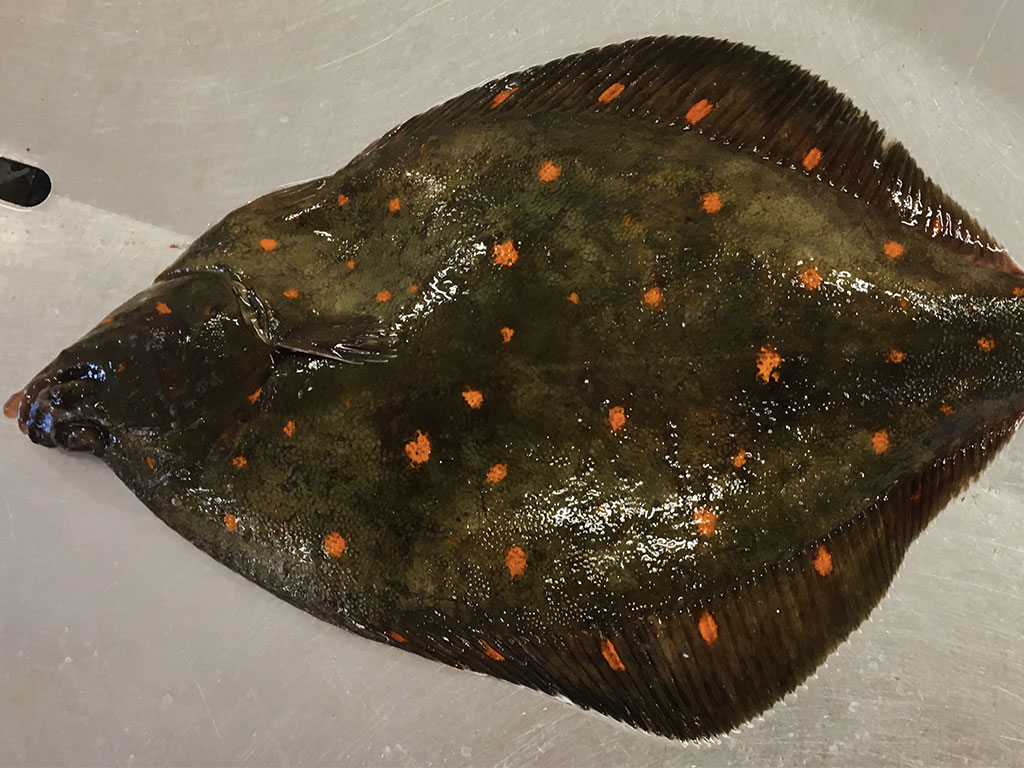
Carrelet / Pleuronectes platessa
Presentation of the Carrelet
Plaice, sometimes called plaice, is a very common flatfish, easily recognizable by its orange spots on its back. It is fished in the Channel and Brittany, where it is very abundant: this fish is not threatened and the state of the stocks is excellent. Plaice is also one of the healthiest, leanest and most nutrient-rich fishes, with very little contamination from environmental pollutants.
Quality :
Inshore fishing” square
Trawl net square
Proposed transformation:
Empty whole square *
Fillet of plaice *
Size & Packaging :
The plaice is packaged in the form of a piece and in the following sizes: 500/1 kg – ½ kg – 2/3
*Packaged according to your needs.

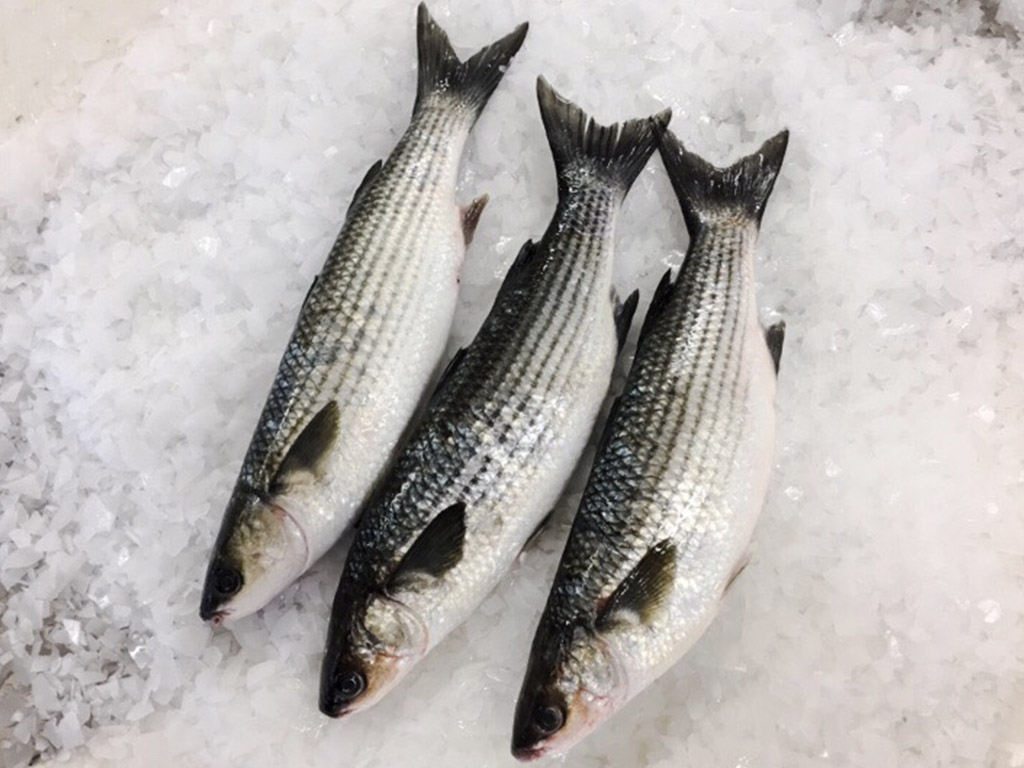
Mulet
Presentation of the mule
The mullet, also known as a “muge”, is a beautiful fish with a tapered body, covered with large silvery scales. The mule is part of a family of about a hundred species, the most common of which is the mule dog.
Quality :
Black Mule
White mullet
Golden Mule
Proposed transformation:
Whole mule
Mule empty, flaked Mule net
Size & Packaging :
The mullet is packed in 6 or 10 kg and according to the following sizes: 5/1 kg – 1/2 kg – 2+ kg
*Packaged according to your needs.

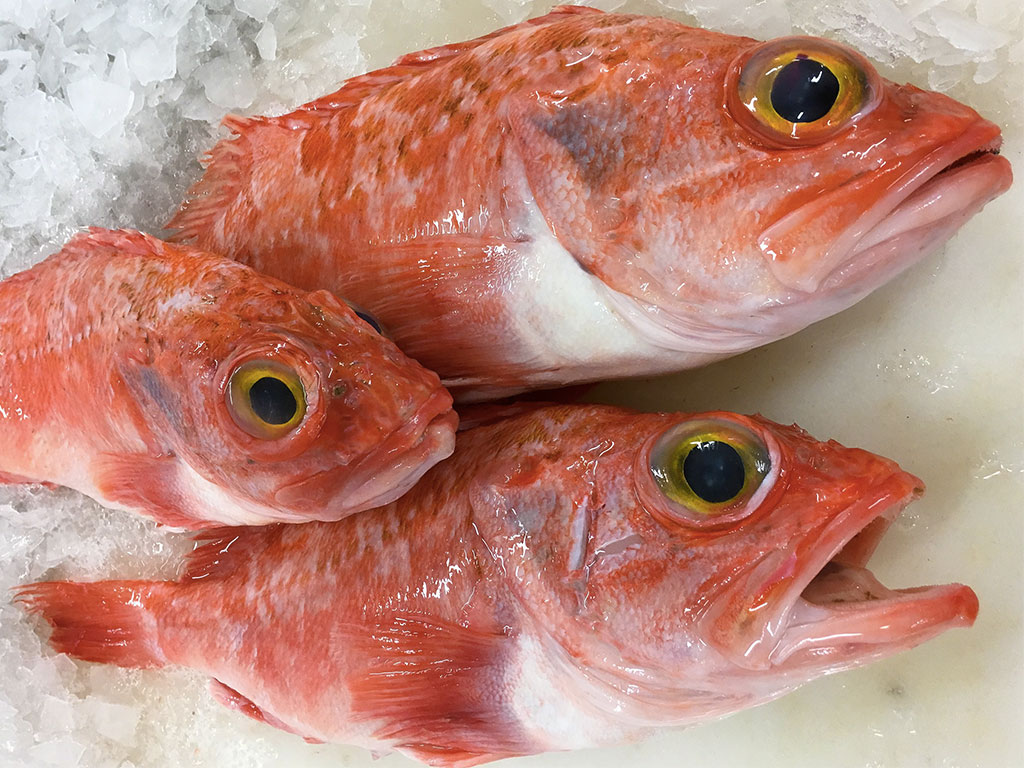
Rockfish / Sebastes norvegicus
Rockfish presentation
Rockfish is a long-lived species. It lives on the rocky bottoms of the continental slope northeast of the Arctic Ocean. Three species of Rockfish are frequently found in Norwegian waters. First of all, “Atlantic redfish”, or simply “Rockfish”, is the most common species. It is a fish that lives in relatively shallow water – less than 500 meters
Proposed transformation:
Whole Rockfish
Rockfish fillet*
Size & Packaging :
Rockfish is packed in 3.6 kg and in the following sizes: 3/500 gr – 600 +
*Packaged according to your needs.
**Ready to Cook
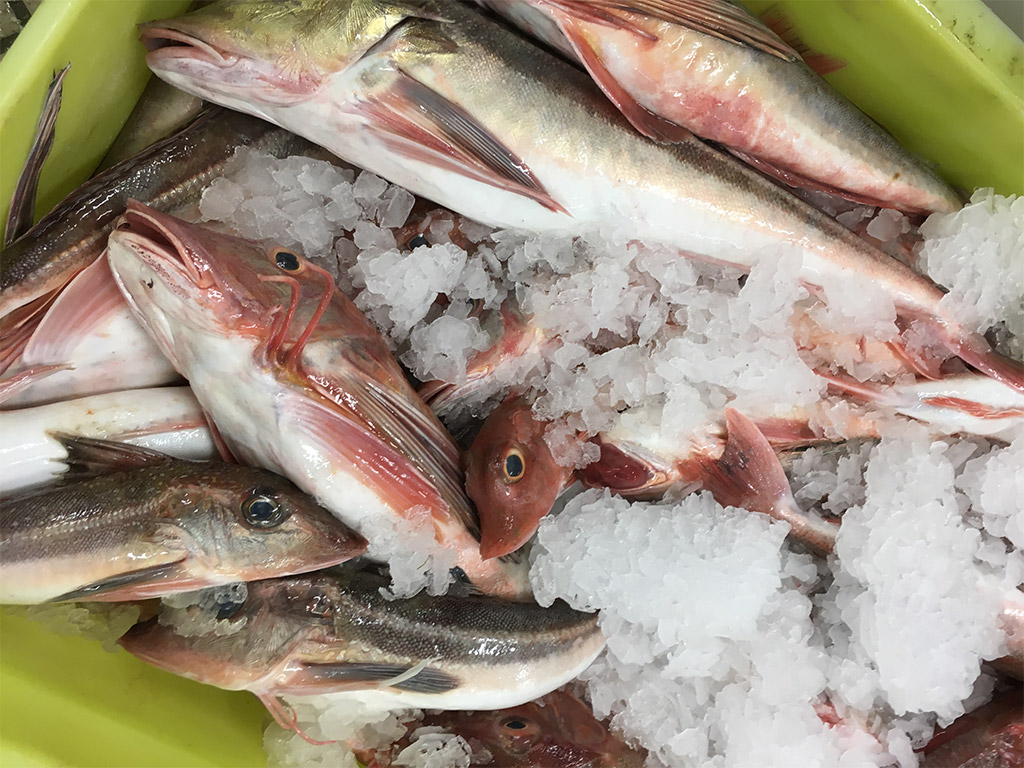


Perlon gurnard / Grondin Perlon
Presentation of the Gurnard
The perlon gurnard (Trigla lucerna), also known as the trigle swallow and gallina or gallinette in southern France, is a species of teleosteal fish. It is called “gurnard” because of the wind noises it produces, which sound like rumblings. The gurnard weighing more than 1 kg is often called a “tombe”.
Proposed transformation:
Whole gurnard or empty
Gurnard Fillet*
Size & Packaging :
The Gurnard is packaged in 3, 6.10 kg and according to the following sizes: 3/500 gr – 5/1kg gr – ½ kg – 2+
*Packaged according to your needs.
**Ready to cook

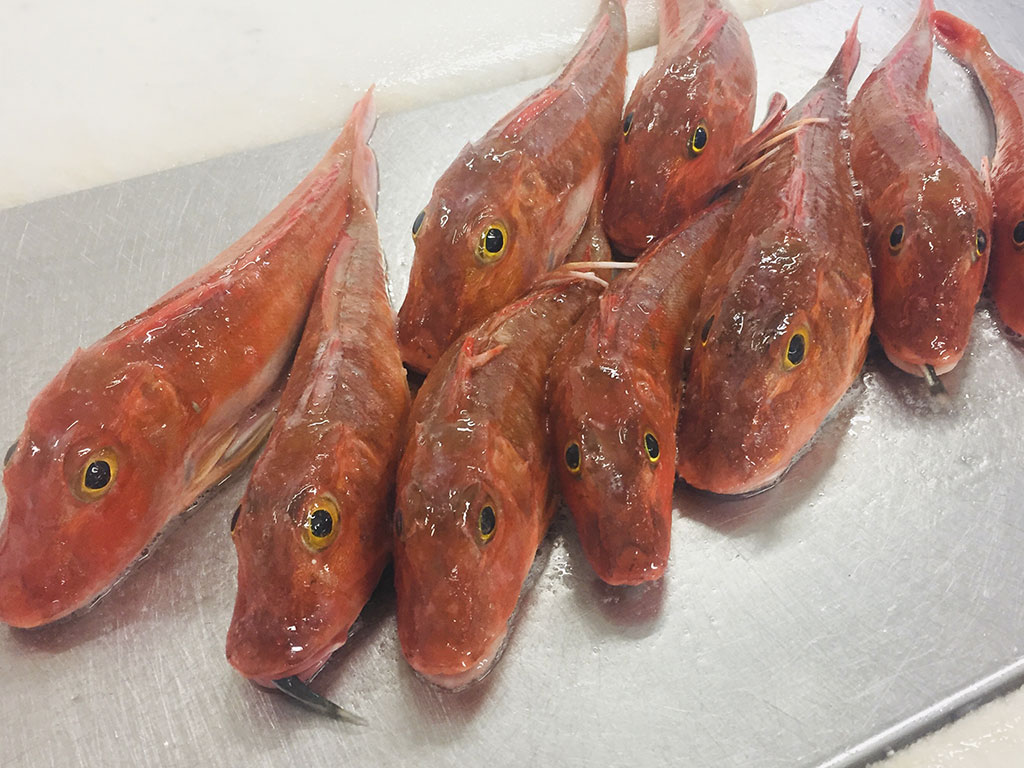
Red gurnard / Trigla lucerna
Presentation of the red gurnard
Especially present in northern waters (English Channel and North Sea), the red gurnard digs the sand with its large head with barbels. Its orange colour more or less camouflages it in its environment but as soon as it is in movement its fins unfold and display a beautiful red colour.
Quality :
Red gurnard, coastal peach
Trawl gurnard
Proposed transformation:
Whole red gurnard
Empty gurnard
Fillet of gurnardine
Size & Packaging :
The gurnard is packaged in 3 and 6 kg and according to the following sizes: 3/500 gr – 500/800 gr – 800/1 kg – 1+ kg
*Packaged according to your needs.

Sar / Diplodus sargus
Presentation of the sar
There are different species of sars. The smallest are spiders, also called pataclets, their maximum size is 25 cm. The sar feeds mainly on shellfish, crustaceans, molluscs, worms and fish. Crab, shrimp, sea urchins and mussels are the main part of its diet. sar is a fish found in open water, near the bottom
Quality :
Sar coastal fishing
Sar trawl net
Proposed transformation:
Whole Sar
Sar emptied, flaked
Sar fillet
Size & Packaging :
The sar is packaged in 3,6 or 10 kg and according to the following sizes: 3/500 gr – 5/800 kg 800/1 kg – 1/2 kg – 2+ kg
*Packaged according to your needs.
Cephalopods
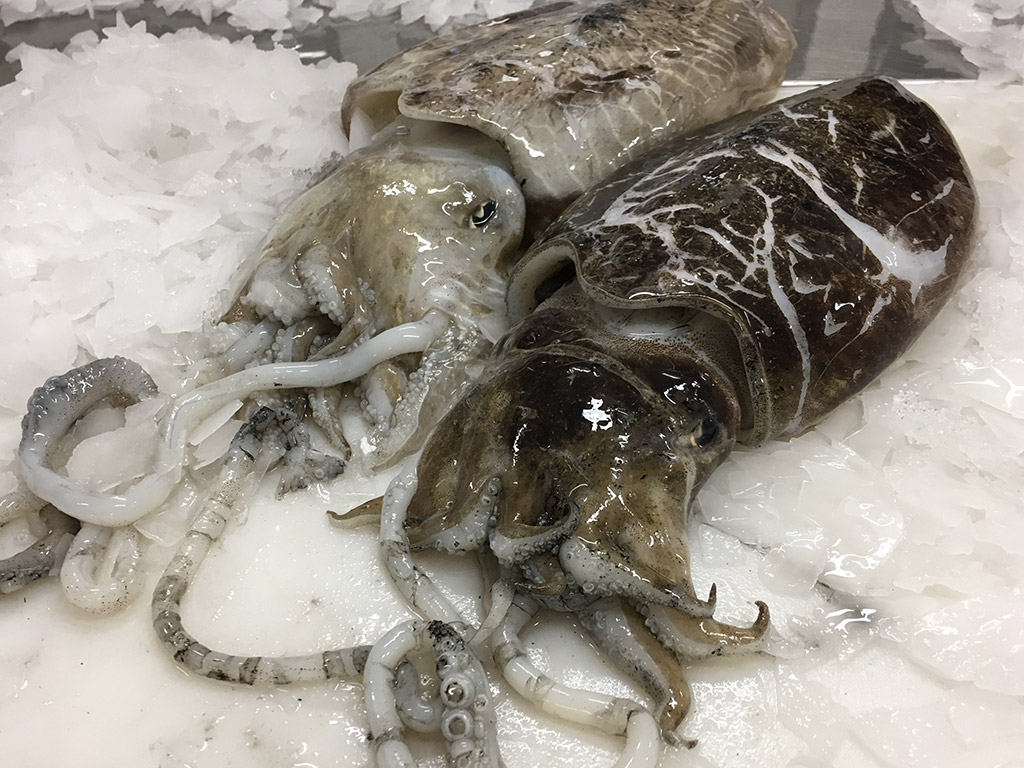
Seiche / Sepia officinalis
Presentation of the Cuttlefish
The cuttlefish is a cephalopod mollusc of the decapod family (ten arms or tentacles), so it is not related to the octopus or octopus that have eight arms. It should also not be confused with squid or squid. Possessing exceptional vision, cuttlefish also have a capacity for mimicry that allows them to change colour, which often makes them difficult to see. On its ten arms equipped with suction cups, two tentacles are used to capture its prey. The cuttlefish has a bone. The cuttlefish bone is used to manage its buoyancy. Generally, cuttlefish are 20 and 30 centimetres long.
Quality :
Dry “locker” drying
Trawl dryer
Proposed transformation:
Whole cuttlefish
Cuttlefish white *
Size & Packaging :
The cuttlefish is packaged in 4 and according to the following sizes: 1/200 gr – 2/300 gr – 3/500 gr – 500/1 kg + 1 kg
*Packaged according to your needs.
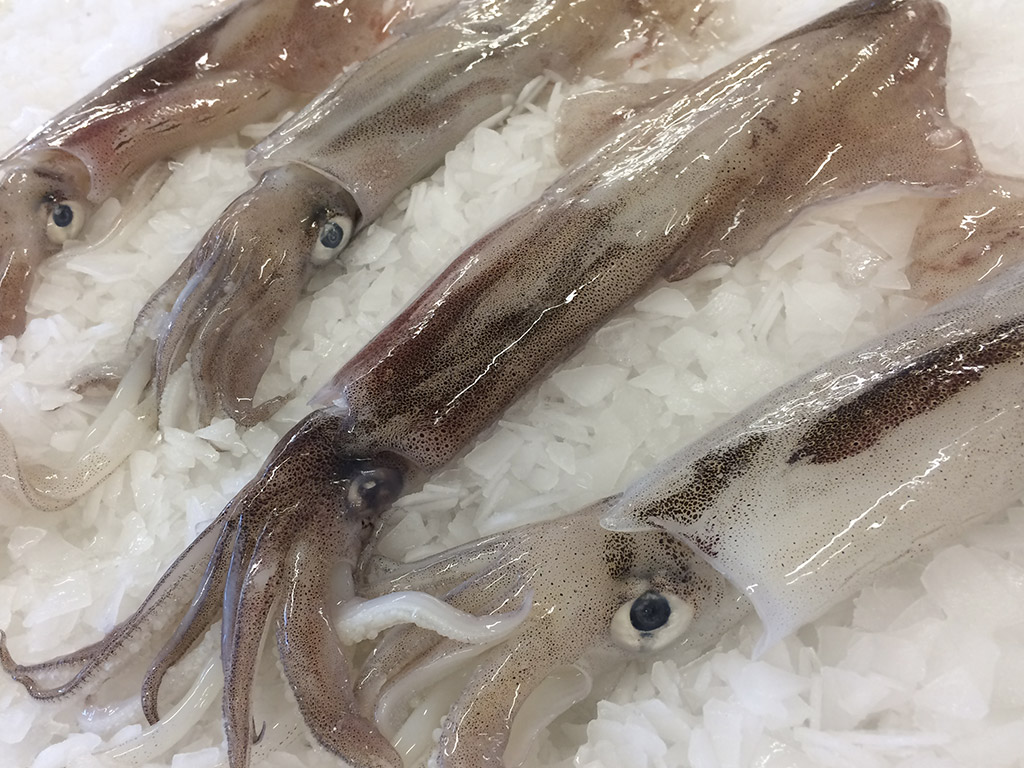
Encornet / Loligo vulgaris
Presentation of the squid:
Squid is also called squid, squid, squid, cone, chipiron or supiron.
It measures 30 to 40 cm without tentacles. In adulthood, it can reach up to 50 cm.
Its weight is generally between 300 and 700 g.
Quality :
White squid
Red or wild squid
Size & Packaging :
The squid is packaged in 3 kg and in the following sizes: 1/200 gr – 2/300 gr – 3/500 gr – 500 gr +

Poulpe / octopus vulgaris
Presentation of Octopus:
The octopus, also commonly known as octopus, takes its name from the Greek “polypus” which means “several feet”. Its 8 tentacles, adorned with hundreds of suction cups and reaching up to 1 m each, allow it to smell and taste its prey. Amazing fact: if one of his arms were to be severed, it would naturally grow back! To defend itself against its predators or to eat, the octopus uses a powerful mouth shaped like a parrot beak capable of crushing shells.
Quality :
Octopus” coastal fishing”.
Octopus trawl
Proposed transformation:
Whole octopus
Size & Packaging :
The octopus is packaged in 3, 6 or 12 kg or as a piece and according to the following sizes: ½ kg – 2/3 kg – 3 kg +
Blue Fish
Anchovy / Engraulis encrasicolus
Presentation of Anchovies
It is characterized by a slender, slender and subcylindrical body. Its upper jaw is clearly prominent. The mouth ends far behind the eyes. The anal fin begins behind the last two rays of the ridge. Entirely covered with scales, the body is silvery on the back and bluish on the belly. From 10 to 15 cm long, it can reach a maximum of 20 cm. Its food is composed of zooplankton as well as phytoplankton.
Anchovies are marketed whole fresh, in pickled or salted fillets. Anchovies can be eaten fried, pan-fried, or in a steakhouse. It can also be marinated in olive oil and lemon. In France, anchovies are combined with many southern dishes such as pissaladière, bagna cauda and tapenade.
Size & Packaging :
The anchovy is packaged in 4 kg



Sardines / Sardina pilchardus
Sardine presentation
Known and recognized for its taste and nutritional qualities, sardines have long been the delight of young and old. Frequently fished since ancient times, its name comes from the Greek derivative “Sardiné” which means Sardinia (island around which sardines were particularly abundant).
Coming from Clupeidae, it is often confused with other species in the family such as herring and shad. Measuring on average 10 to 15 cm, it can be recognized by its striated operculum, its bright blue-green colour, its silvery belly and its large scales that are easily detachable.
Quality :
“Bolinsh” Sardine
Proposed transformation:
Whole sardine
Headless gutted sardine*
Double sardine net*
Size & Packaging :
The sardine is packaged in 3 or 4 kg.
*Packaged according to your needs.


Chinchard / Trachurus Trachurus
Presentation of horse mackerel:
Of the Carangidae family, horse mackerel bears the Latin name Trachurustrachurus. Named “caringue”, “sévereau”, “mackerel anglais”, “saurel” or “coulirou” (in the West Indies), this rough to the touch fish has a silvery body with metallic shards. With a line of formidable spines to defend it, its thorny lateral line distinguishes it from mackerel, with which it can easily be confused. While it is not uncommon to see them rubbing shoulders, horse mackerel also differs by a black spot generally visible on the lid.
Quality :
Inshore fishing” horse mackerel
“Bolinche” Horse Mackerel
Yellow-tailed Horse Mackerel
Size & Packaging :
Horse mackerel is packed in 3 or 6 kg and in the following sizes: 2/300 gr – 3/500 gr
*Packaged according to your needs.


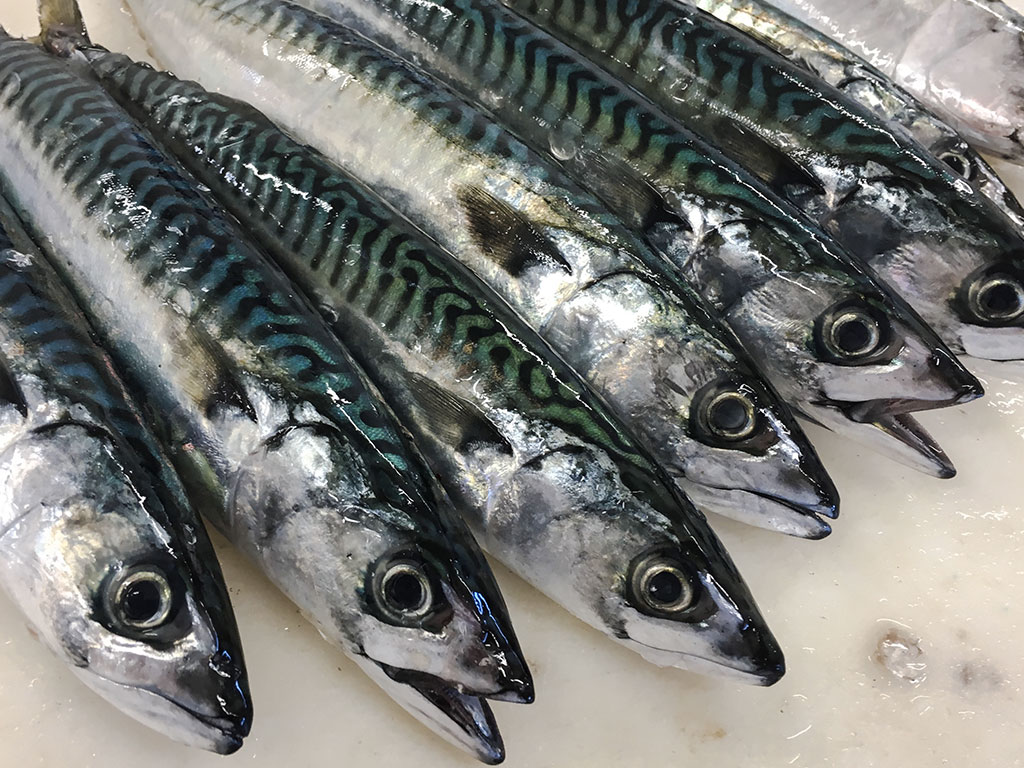
Mackerel / Scomber scombrus
Presentation of mackerel
Mackerel is a semi-fat pelagic fish (rich in omega three), present along our coasts. A tireless swimmer, mackerel live in compact schools. Mackerel live on the continental shelf, up to 250 m deep, in compact banks near the surface. Mackerel measures about 50 cm and weighs an average of 500 grams. The mackerel is recognizable among all with its beautiful blue zebra livery and white belly. This gregarious and fast pelagic (about 10 km per hour) is related to tunas.
Quality :
Mackerel “coastal fishing”
Mackerel in tank
Spanish Mackerel – Bizet
Size & Packaging :
The mackerel is packed in 3 or 6 kg 18 and according to the following sizes: 2/300 gr kg – 3/500 gr – 500 gr


Orphie / belone belone
Presentation of the orphy
The orphrey is a snake-like fish with a long beak armed with fine, sharp teeth. The lower beak is slightly longer than the upper one. This fish has the particularity of having green bones. The average adult size is 30 cm (max. 100 cm).
This fish has a very special smell when raw (“metallic”, similar to the smell of barracuda), but its flesh is quite firm and tasty when cooked and looks “a little” like that of sole. Cut into sections and fried in butter with pepper and salt, the aiguillette or or orphie will have enthusiasts.
Size & Packaging :
The garfish is packaged in 6 kg.
Shellfish
Lobster / homarus gammarus
Lobster presentation
Lobster is a decapod crustacean, living in the sea. The genus Homarus includes two species: the European lobster (called in France, Breton lobster), the American lobster (also called Canadian lobster).
Lobster is easily distinguished from lobster by the presence of large claws and a less thorny shell.
Lobster meat is famous. It is considered by some to be the finest of crustaceans, ahead of the crayfish. According to connoisseurs, the two species of lobster do not have quite the same flavor.
Conditioning
Sold by the piece, according to your needs.
Sea spider crab / Maja Squinado
Presentation of the sea spider crab
On the French coast, Brittany and Normandy, a spider crab is essentially one of the following species: Maja squinado or Maïa squinado. Sea spiders are large crustaceans, found on the French coast, that live from 0 to 120 m deep depending on the periods of their breeding cycle. Spider crab is a delicacy that is eaten like crab and its meat is frequently recognized as finer by connoisseurs.
Conditioning
Sold by the piece, according to your needs
Sleeping crab / Cancer Pagurus
Description of the meal
Sleeping or sleeping crab, better known to gourmets as edible crab and sometimes also called moon crab, has the scientific name Cancer Pagurus.
It is a crab very much in demand for its taste and taste. Crabs are a source of vitamin B12 and zinc and contain a lot of vitamin E.
Conditioning
Sold by the piece, according to your needs
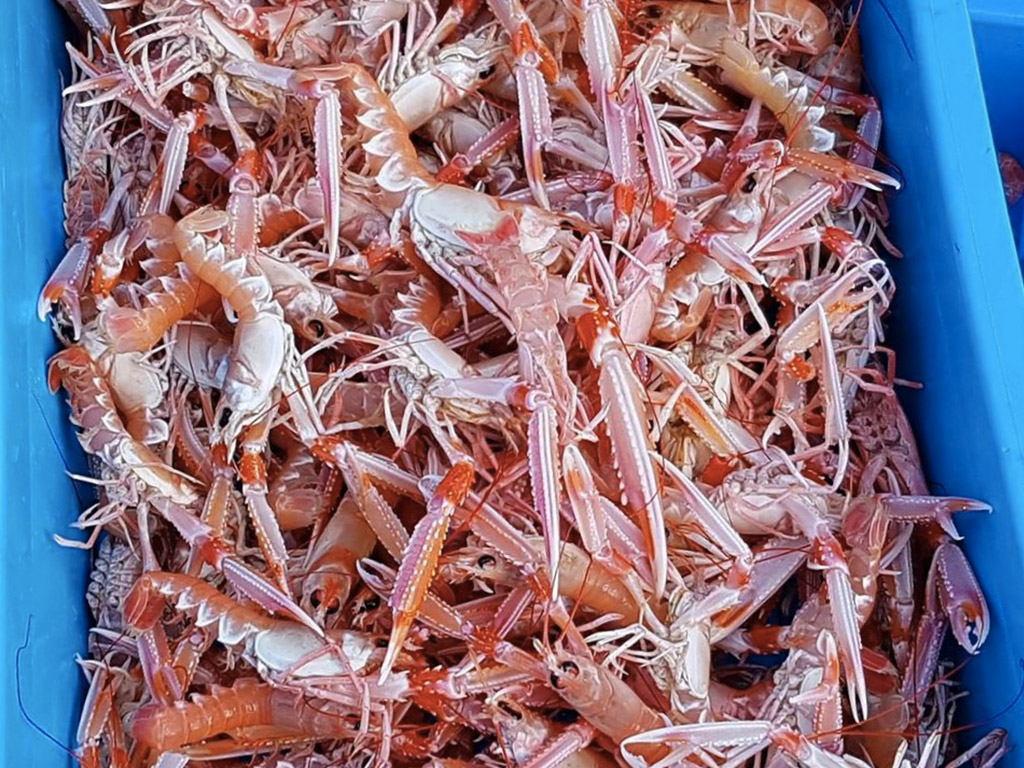


Langoustine / Nephrops norvegicus
Presentation of langoustine
Fished in the English Channel, Celtic Sea, Irish Sea, West of Scotland, Kettegat/Skagerrak, North Sea and Norway, Bay of Biscay and Mediterranean. Small crustaceans not exceeding 20 cm in length, translucent pinkish-yellow in living state, more or less shaded with red and brown.
It spends most of its time in a burrow that it digs in the muddy bottoms, between 15 and 800 m and only leaves it to feed on small crustaceans and molluscs.
Quality :
Live Norway lobster
Norway lobster red leg
Ice scampi
Size & Packaging :
Nephrops are packed in 3 kg and in the following sizes: 10/15 – 15/20 – 20/30 – 7/10 – 5/7 – 3/5 **
** number of Norway lobster per kilogram
Monkfish



Lotte / Lota lota
Presentation of the monkfish
Nicknamed the devil or sea toad because of its repulsive appearance, the common anglerfish is most often called the “monkfish” on the stalls of fishermen. Very appreciated for its flesh, it is one of the leanest fish to eat (only 0.7% fat). At maturity, it can reach 2 meters for a total weight of 45kg.
Quality :
Inshore fishing lobster
Spinner” turnip (Roscoff, Audierne)
Trawl trawl net
Proposed transformation:
Whole turnip: Parting
Monkfish tail, with or without flank
Monkfish fillet, Monkfish cheek, Monkfish liver
Size & Packaging :
The monkfish tail is packed in 3,6 or 12 kg and according to the following sizes: 3/500 gr – 500/1kg – 1/2 kg – 2/4kg – +4kg
*Packaged according to your needs.




